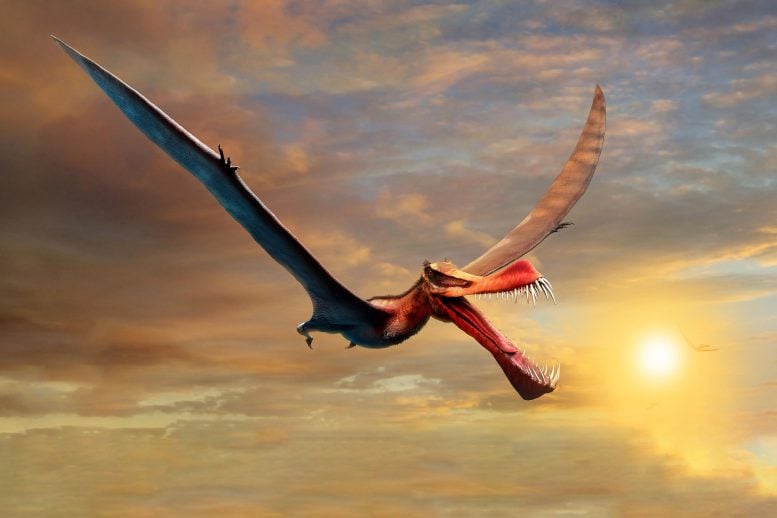
Posted on 08/09/2021 5:56:16 AM PDT by Red Badger

Artist’s impression of the fearsome Thapunngaka shawi. Credit: Adobe stock
=============================================================================================================
Australia’s largest flying reptile has been uncovered, a pterosaur with an estimated seven-meter wingspan that soared like a dragon above the ancient, vast inland sea once covering much of outback Queensland.
University of Queensland PhD candidate Tim Richards, from the Dinosaur Lab in UQ’s School of Biological Sciences, led a research team that analyzed a fossil of the creature’s jaw, discovered on Wanamara Country, near Richmond in North West Queensland.
“It’s the closest thing we have to a real life dragon,” Mr. Richards said.
“The new pterosaur, which we named Thapunngaka shawi, would have been a fearsome beast, with a spear-like mouth and a wingspan around seven meters.
“It was essentially just a skull with a long neck, bolted on a pair of long wings.
“This thing would have been quite savage.
“It would have cast a great shadow over some quivering little dinosaur that wouldn’t have heard it until it was too late.”
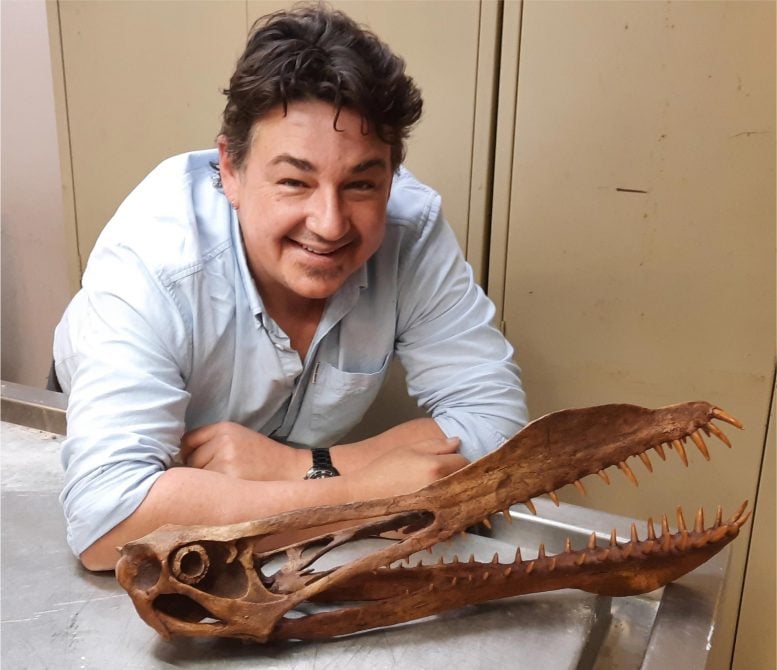
Tim Richards with the skull of an anhanguerian pterosaur. Credit: Tim Richards
================================================================================================================
Mr. Richards said the skull alone would have been just over one meter long, containing around 40 teeth, perfectly suited to grasping the many fishes known to inhabit Queensland’s no-longer-existent Eromanga Sea.
“It’s tempting to think it may have swooped like a magpie during mating season, making your local magpie swoop look pretty trivial – no amount of zip ties would have saved you.
“Though, to be clear, it was nothing like a bird, or even a bat – Pterosaurs were a successful and diverse group of reptiles – the very first back-boned animals to take a stab at powered flight.”
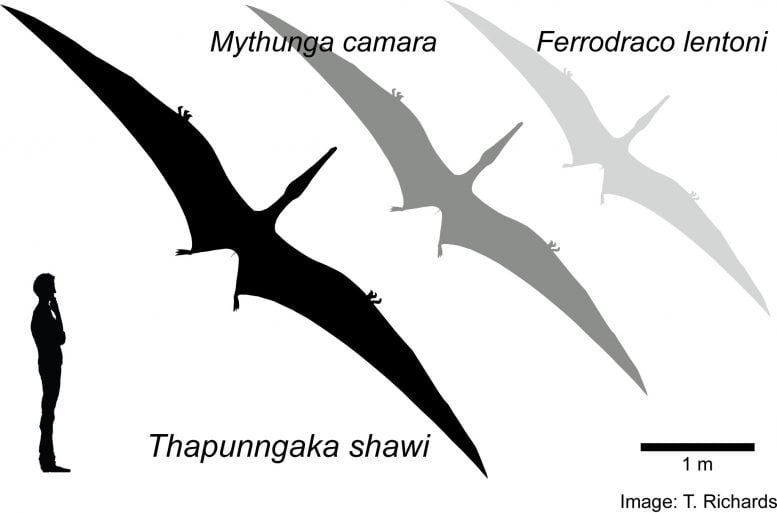
Hypothetical outlines of Australian pterosaurs showing relative wingspan sizes. 1.8 m human for scale. Credit: Tim Richards ==================================================================================================================
The new species belonged to a group of pterosaurs known as anhanguerians, which inhabited every continent during the latter part of the Age of Dinosaurs.
Being perfectly adapted to powered flight, pterosaurs had thin-walled and relatively hollow bones. Given these adaptations their fossilized remains are rare and often poorly preserved.
“It’s quite amazing fossils of these animals exist at all,” Mr Richards said. “By world standards, the Australian pterosaur record is poor, but the discovery of Thapunngaka contributes greatly to our understanding of Australian pterosaur diversity.”
It is only the third species of anhanguerian pterosaur known from Australia, with all three species hailing from western Queensland.
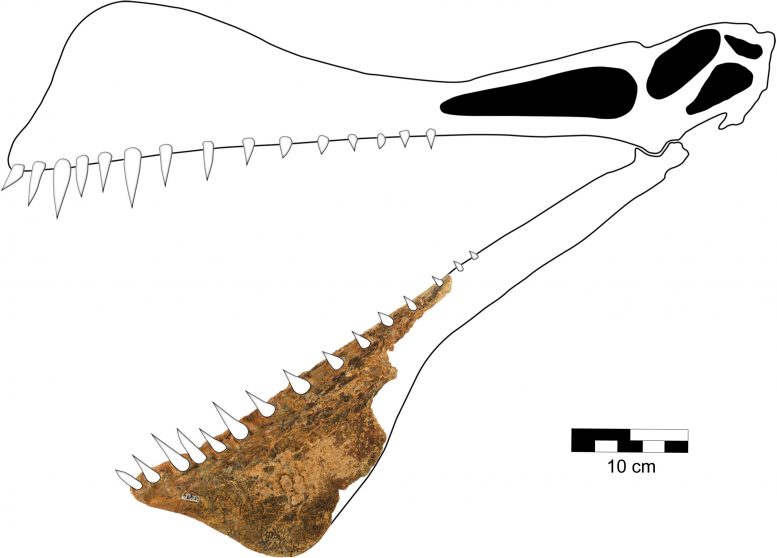
Reconstruction of the skull of Thapunngaka shawi (KKF494). From Richards et al. (2021). Credit: Tim Richards
=========================================================================================================
Dr. Steve Salisbury, co-author on the paper and Mr Richard’s PhD supervisor, said what was particularly striking about this new species of anhanguerian was the massive size of the bony crest on its lower jaw, which it presumably had on the upper jaw as well.
“These crests probably played a role in the flight dynamics of these creatures, and hopefully future research will deliver more definitive answers,” Dr. Salisbury said.
The fossil was found in a quarry just northwest of Richmond in June 2011 by Len Shaw, a local fossicker who has been ‘scratching around’ in the area for decades.
The name of the new species honors the First Nations peoples of the Richmond area where the fossil was found, incorporating words from the now-extinct language of the Wanamara Nation.
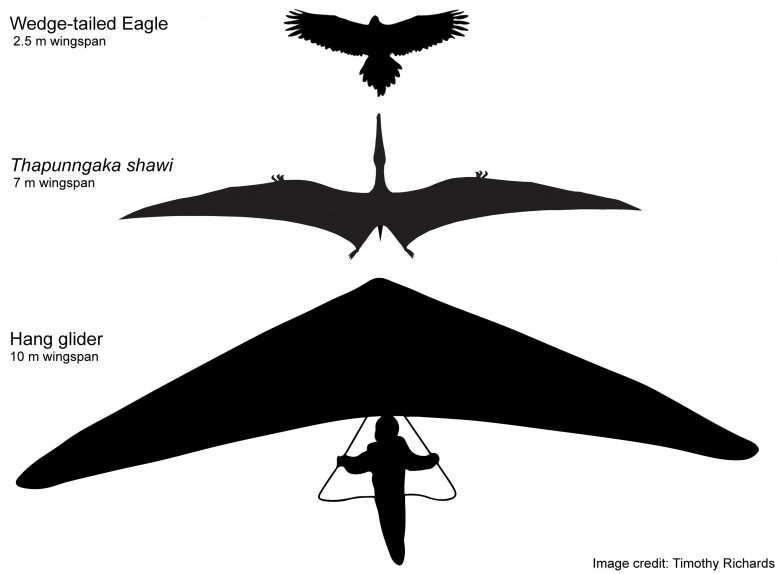
Hypothetical outline of Thapunngaka shawi with a 7 m wingspan, alongside a wedge-tailed eagle (2.5 m wingspan) and a hang-glider (10 m ‘wingspan’). Credit: Tim Richards
==========================================================================================================
“The genus name, Thapunngaka, incorporates thapun [ta-boon] and ngaka [nga-ga], the Wanamara words for ‘spear’ and ‘mouth’, respectively,” Dr. Salisbury said.
“The species name, shawi, honours the fossil’s discoverer Len Shaw, so the name means ‘Shaw’s spear mouth’.”
The fossil of Thapunngaka shawi is on display at Kronosaurus Korner in Richmond.
Reference: “An Upper Triassic Terrestrial Vertebrate Assemblage from the Forgotten Kocury Locality (Poland) with a New Aetosaur Taxon” by Łukasz Czepiński, Dawid Dróżdż, Tomasz Szczygielski, Mateusz Tałanda, Wojciech Pawlak, Antoni Lewczuk, Adam Rytel and Tomasz Sulej, 6 April 2021, Journal of Vertebrate Paleontology. DOI: 10.1080/02724634.2021.1898977
Ping!.................
Looks like they have a litte oil production in that region, but perhaps they need to bring in more rigs. Sounds worth wildcatting to me.
About a 23 foot wingspan. Huge.

I want one. I want one cloned now.
Beaky Buzzard!!!
“Aww, nope nope nope nope… not gonna do it, duhhhh .. nope.”
Thank you! I get so tired of people constantly pushing all that metric gibberish.
I remember reading years ago about an Ostrich rancher in Australia losing almost his entire flock when they were stampeded by an ultra-light aircraft passing overhead and the ‘herd’ got entangled in wire border fencing with broken limbs and pretty much died of fright.
Genetic memories of a large winged predator?
Ostrich are like giant chickens.......................

..... Where the in-flight meal is................YOU!...............
Where the menu is a mirror.
Nice find. Was the skull that Mr. Richards (presumably Dr. Richards by now) is posing with... a reconstruction of what they thought it should have looked like based on the amount of material they actually found? From the schematic diagram there is a small section of a brownish stippled color depicted. The rest is in black and white. My guess is that brown stippled area is all they found. So lots of conjecture is at play, it would seem.
Interesting to say the least. Thunderbird, phoenix, puff the magic dragon, rocs ,may not be so fanciful after all.
Did you ever read “The Lost World” by Sir Arthur Conan Doyle? Same author of the Sherlock Holmes series.
It has spawned many, many movies, since it publishing in 1912.
In it, the adventurers brought back a pterosaur to London!.................
There’s a reason those front two seats are called ‘Jump’ Seats!.................
Quetzalcoatlus supposedly had a 10+ meter wingspan and stood as tall as a giraffe on the ground, 10 feet high at the shoulder. I guess some people originally estimated it might have had a 15 meter wingspan, around 50 feet.
Freegards

I’m thinking its natural prey would be to snatch smaller flyers out of the air.
Disclaimer: Opinions posted on Free Republic are those of the individual posters and do not necessarily represent the opinion of Free Republic or its management. All materials posted herein are protected by copyright law and the exemption for fair use of copyrighted works.